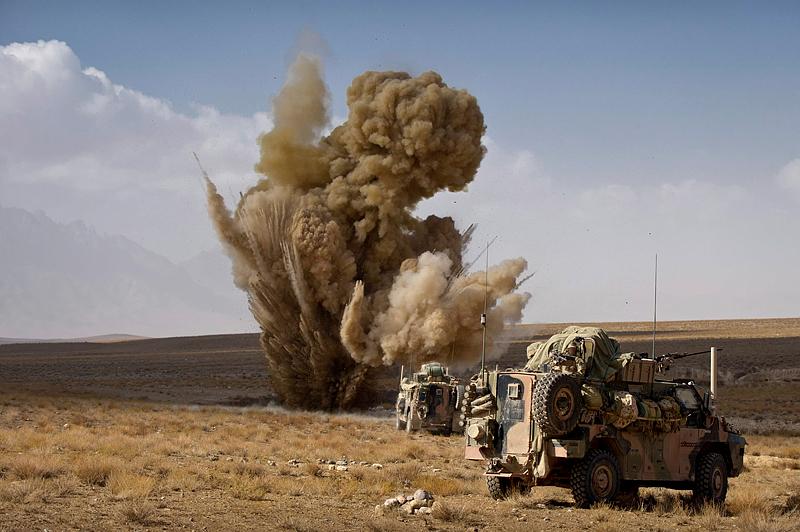How will LAND 400 vehicles survive against IEDs?
Posted By Bruce Cameron on May 11, 2015 @ 14:00
 [1]
[1]One of the topics at ASPI’s upcoming Army’s Future Force Structure Options Conference [2] is ‘Land 400 and policy issues required for success’. A point of contention regarding LAND 400 Phase 2 is the estimated weight of the vehicles within the future Combat Reconnaissance Vehicle (CRV) family. Some argue that the level of protection being sought will rule out wheeled contenders (with tracks being necessary to provide the requisite mobility). Informed debate regarding the various relevant factors is hard to find. To ensure that there are no preconceived ideas, one has to start with the operational basis for the CRV’s employment.
The LAND 400 Close Combat Storybook [3] states that close combat reconnaissance requires the CRV to be able to withstand an ambush and withdraw to report.
There are three main types of ‘ambush’: indirect fire weapons, direct fire weapons and IEDs (and combinations thereof). Ambushes involving indirect and/or direct fire weapons, can be experienced in both irregular and regular warfare. Both are able to be countered to some extent by tactical movement utilising vehicle speed and formation. Furthermore, likely ambush sites can often be identified and appropriate drills used. Speculative fire can also be employed to ensure a suspect location is ‘safe’.
The greatest risk to a CRV is an IED ambush. This is a constant threat. It used to be that suitable sites were limited to defiles which would channel movement or culverts which could be packed with explosives. Pressure switches were the only method of initiation. Not anymore; today the use of IEDs is a sophisticated method of warfare in its own right.
Reconnaissance vehicles achieve protection through high mobility (speed, agility and cross country performance); firepower (being able to achieve fire superiority); self-screening instantaneous smoke; supporting fires (both indirect and direct); vehicle design; and armour. The last is generally thought of as adding considerable weight to a vehicle but there are options such as appliqué armour (which can be added for a particular threat scenario). Vehicles can also incorporate blast absorption materials, blast deflection angles and internal spall liners. Clever use of materials can result in a design which can mitigate the transfer of blast effects to the interior of the vehicle.
In his post, ‘Introducing ASPI’s 2015 International Conference: Army’s Future Force Structure Options’ [4], Michael Clifford observes that ‘the Bushmaster vehicle has been a revelation on operations in Afghanistan and Iraq and has proven to be one of the capability ‘finds’ of the decade’. It is no surprise that the Bushmaster has a V-shaped hull which protects it against buried IEDs by deflecting blast away from the vehicle.
IEDs can be positioned to fire: upwards from the ground; sideways from embankments and buildings; and downwards from trees, underpasses and the like. The latter two threats can be countered to some extent by speculative fire and route selection. Suitable sites are also generally much harder to find than for the buried IED. It is this threat which is creates the greatest risk. An IED with sufficient power to knock out a reconnaissance vehicle can be buried anywhere. The question is, how can the blast effect be minimised to enable the CRV to survive and withdraw to an overwatch position?
A hull shaped to deflect the blast is obviously desirable. However, this immediately raises other questions . Where should protection levels be prioritised to provide the CRV with the greatest chance of survival? Should upper vehicle ballistic/HEAT protection be at the same level as hull blast protection? Can one be increased at the expense of the other? It also has to be asked if different levels of upper vehicle protection be achieved through the use of appliqué armour, thereby allowing the CRV to be tailored for different operational scenarios (albeit possibly with some loss of mobility). If appliqué armour was an option, is it possible that future developments might enable lighter appliqué panels to be utilised, thereby minimising the mobility disadvantage?
The greatest threat from IEDs is that which exists when movement is channelled by the terrain (for instance, jungle or desert). The basis of provisioning for the CRV includes a manoeuvre support variant. It may be that the tactical employment of this vehicle can help counter the IED threat. However, reconnaissance units must be capable of operating independently over a wide front, and IEDs can be designed to be detonated by the second or third vehicle that passes over them.
Hardware solutions to an operational requirement can’t be predetermined; the materiel cycle is tried and tested. The CRV to be procured will only be the best possible, if its operational requirements have been fully contested. In this respect, IEDs are likely to constitute the primary threat to the survivability of the vehicle. It’s hard to see how protection levels can be anything other than rigorous in this respect. However, other options relating to the vehicle’s survivability, which impact on its weight, are available.
Article printed from The Strategist: https://aspistrategist.ru
URL to article: /how-will-land-400-vehicles-survive-against-ieds/
URLs in this post:
[1] Image: https://aspistrategist.ru/wp-content/uploads/2015/05/20101030adf8239682_293.jpg
[2] Army’s Future Force Structure Options Conference: https://www.aspistrategist.ru/events/armys-future-force-structure-options
[3] The LAND 400 Close Combat Storybook: http://www.defence.gov.au/dmo/Multimedia/LAND400_CloseCombatStoryboard-9-5562.pdf
[4] ‘Introducing ASPI’s 2015 International Conference: Army’s Future Force Structure Options’: https://aspistrategist.ru/introducing-aspis-2015-international-conference-armys-future-force-structure-options/
Click here to print.